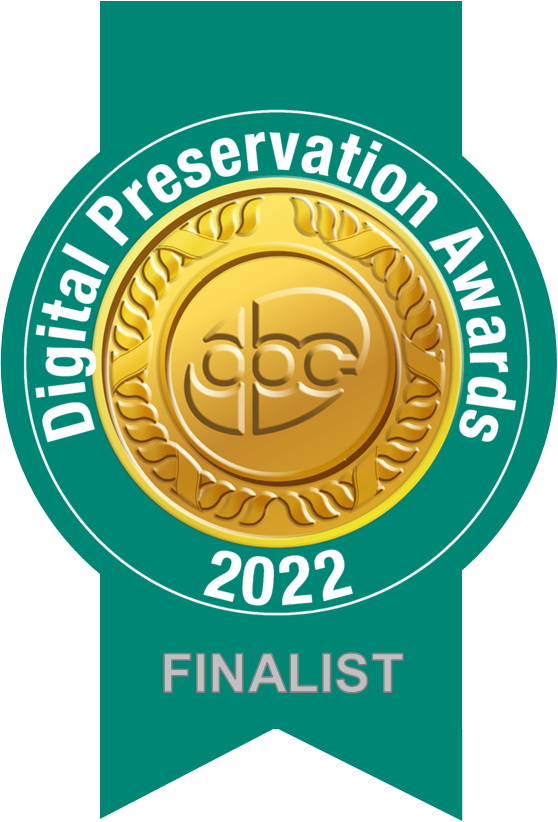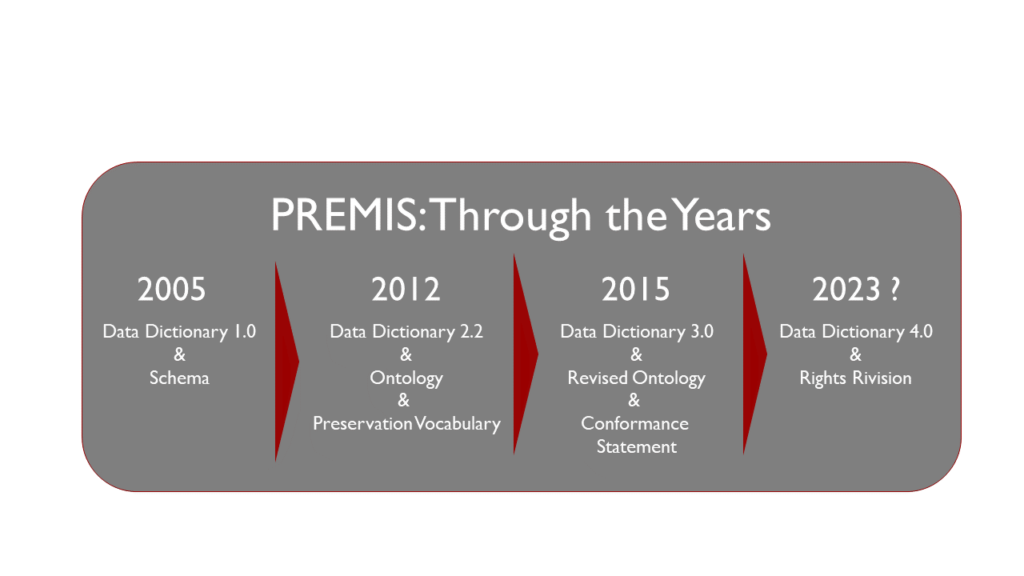This blogpost is written by Tracy Meehleib (Library of Congress), Karin Bredenberg (Sydarkivera) and Micky Lindlar (TIB)
A lot has been going in with PREMIS this year! From being short-listed for the prestigious DPC 20th Anniversary Award, to work on the Rights Entity, the PREMIS Editorial Committee has had their hands full. Read on for a short update on recent activities.
Digital Preservation Awards 2022 – Finalist for the DPC 20th Anniversary Award at iPRES 2022

The PREMIS Data Dictionary and Related Resources was selected as one of three finalists for the prestigious DPC 20th Anniversary Award. The PREMIS Data Dictionary for Preservation Metadata is the international standard for metadata to support the preservation of digital objects and ensure their long-term usability. The Data Dictionary defines preservation metadata that:
- Supports the viability, renderability, understandability, authenticity, and identity of digital objects in a preservation context
- Represents the information most preservation repositories need to know to preserve digital materials over the long term
- Emphasizes “implementable metadata”: rigorously defined, supported by guidelines for creation, management, and use, and oriented toward automated workflows
- Embodies technical neutrality: no assumptions made about preservation technologies, strategies, metadata storage and management, etc.

Here’s a brief history of PREMIS: The first PREMIS Data Dictionary and the first PREMIS schema were introduced in 2005 by the PREMIS Working Group. A main design principle from the beginning was that the PREMIS Data Dictionary should be as flexible as possible in implementation. Consequently, no assumptions were made regarding the nature of the digital archiving system in which the Data Dictionary would be implemented, the preservation strategy that would be followed, or the metadata management processes responsible for creating and maintaining preservation metadata. The technical neutrality built into the design of the Data Dictionary was intended to maximize its applicability across a broad range of digital preservation contexts. Soon after the release of the dictionary and schema, the PREMIS Editorial Committee took form and was charged with the ongoing development and maintenance of the standard. In 2012, The PREMIS EC published version 2.2 of the Data Dictionary–along with additional supporting documentation (a revised schema, a data model, implementation guidance, a hierarchical listing of semantic units, an OWL ontology, and a set of linked data). The ontology identified the classes and properties used to describe preservation metadata in RDF–in alignment with PREMIS Data Dictionary version 2.2. In 2015, the PREMIS EC published version 3.0 of the PREMIS Data Dictionary <https://www.loc.gov/standards/premis/v3/> and also issued further support and guidance for the existing standard when it published a conformance statement <https://www.loc.gov/standards/premis/premis-conformance-20150429.pdf > to encourage inter-repository data exchange, repository certification, automation, and shared registries. The PREMIS EC reworked the PREMIS Ontology from 2016-2018 and released a new version of the ontology and an update to the related preservation vocabulary in 2019 based on version 3.0 of the PREMIS Data Dictionary. During the last two years a PREMIS EC subgroup has been exploring how to model different levels of rights, such as privacy, property, and access. The PREMIS EC subgroup working on rights recently drafted a white paper on rights and its suggested approach will be introduced at iPres 2022 in Glasgow. In addition, the rights subgroup is currently working on updating the Rights Entity and this update will be released in version 4.0 of the PREMIS Data Dictionary.
Come and celebrate PREMIS with us at iPres!
Sign up for: The PREMIS Introductional Tutorial, Monday, September 12th, 9:30AM – 1:00PM, Auditorium B and Webcast
Hear about the work we’ve accomplished regarding rights: Short Paper: The 2022 Revision of the PREMIS Rights Entity, Thursday, September 15th, 10:30 AM – 10:45 AM, Auditorium B and Webcast
Ontology Work
The PREMIS EC updated supporting documentation for version 3.0 of the PREMIS Ontology <https://www.loc.gov/standards/premis/ontology/owl-version3.html> to make it easier for new users to acquaint themselves with the various documents that support the use of it. In addition, a PREMIS EC subgroup is currently working with the ICA EGAD <https://www.ica.org/en/about-egad> Records in Context-Ontology (RiC-O) subgroup to explore similarities and differences between the PREMIS Ontology and the RiC-O so users can understand both ontologies and how and when to apply them.
Outreach
The PREMIS EC has devoted considerable effort toward educational outreach in the digital preservation community. This effort has primarily taken the form of a series of tutorials aimed at acquainting participants with the PREMIS Data Dictionary, providing a comprehensive overview of the Dictionary’s contents, and discussing key implementation issues. The tutorials often include a panel of representatives from institutions and projects currently implementing PREMIS, who share and discuss their preservation metadata experiences and perspectives. This year PREMIS EC will offer an open tutorial at iPRES in Glasgow, Scotland. In addition, the PREMIS EC is available to do tutorials upon request.
Administrative Work
The PREMIS EC is also tackling almost 20 years of administrative growth and we are working on reorganizing our documentation and resources to make them more usable, accessible, and maintainable—this work is resulting in a gradually more simplified website design that incorporates and links out to other more dynamic sub-services, such as OPF (our new host for our soon to be reorganized wiki), Zenodo <https://zenodo.org/communities/premis/> (our new host service for PREMIS tutorials and papers), and COPTR <https://coptr.digipres.org/index.php/PREMIS_(Preservation_Metadata_Implementation_Strategies)> (our new host for our old Implementation Registry).

